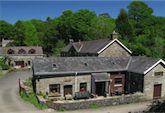If you have ever tried to learn Welsh language phrases or pronounce a Welsh place name, then you will no doubt have noticed that it is quite different to most other European languages. The language of Wales, more properly called Cymraeg in preference to Welsh (A Germanic word denoting “foreigner”), belongs to a branch of Celtic, an Indo-European language descended from something first spoken on the steppes of central Asia. Its nearest cousins are Breton and Cornish.
At the start of the 20th century, the Welsh language was spoken by almost half of the population of Wales. By 1991, although the number of people able to speak the language was still more than half a million (508,098), this represented just 18.7% of the Welsh population. The Swansea Valley is one of the areas in Wales where the Welsh language is still fluently spoken and it can be said to have a character, and to some extent a dialect , that is all its own. Our literature loving holidaymakers will be pleased to know that many Welsh language literary classics have now been translated into English.
The language as spoken today is descended directly from early Welsh, which emerged as a distinct tongue as early as the sixth century AD. It is thus the oldest living language of Great Britain and among the oldest in Europe.
The Act detailing the absorption of Wales into the English state under Henry VIII was the first to refer to the Welsh language: the people of the same dominion have and do daily use a speche nothing like ne consonaunt to the naturall mother tongue used within this Realme, and laid down that English should be the only language of the courts of Wales, and that the use of Welsh would debar one from administrative office. Its explicit intention was: utterly to extirpe alle and singular the sinister usages and customs of Wales. These provisions were symbolically repealed by the 1993 Welsh Language Act.
Welsh was forbidden in schools in the early twentieth century. Anyone caught speaking Welsh had to wear a “Welsh Not”, a piece of wood on a leather strap, known as a cribban, that would be passed on if someone else was heard speaking the language. At the end of the day, the child still wearing the cribban was beaten. The older generation in Wales still remember this practice and it is hardly surprising that use and proficiency of the language plummeted. In 1851, 90% of the Welsh population spoke Welsh. Every decade the figures dropped spectacularly – 49.9% in 1901, 37.1% in 1921, 28.9% in 1951 and 18.9% in 1981. Then for the first time ever, the percentage of Welsh speakers rose, still around the one-fifth mark but showing the most marked increase among the lower age groups, those most able to ensure its future.
The language’s survival is a remarkable story, especially considering the fact that the heart of English culture and its language – the most expansionist the world has ever seen – lies right next door.
The BBC wesbite has excellent resources for those who would like to learn Welsh.
There are many Welsh language books for learners available on Amazon.
